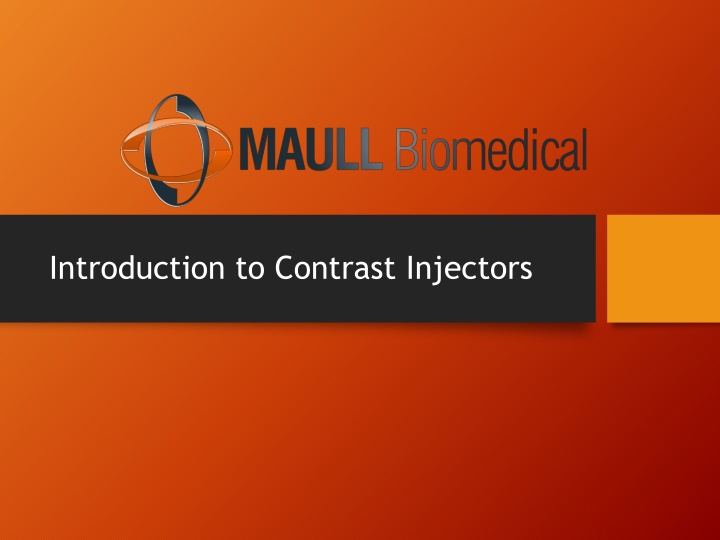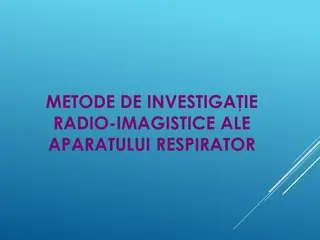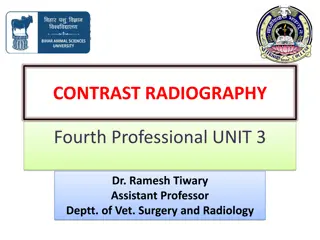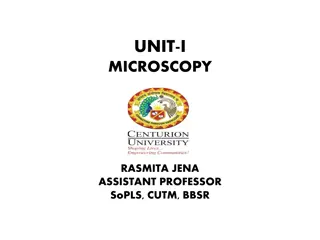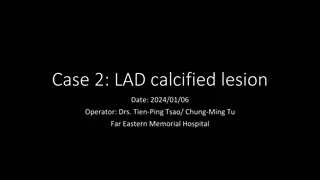Introduction to Contrast Injectors in Angiography
Angiography is a procedure that involves injecting blood vessels with a contrast medium to enhance imaging. Different types of angiographic techniques utilize contrast injectors for better visualization. Major manufacturers of contrast injectors include Bayer/MedRad, Tyco/Covidien, and Bracco/EZEM. Intravenous contrast mediums like iodine and gadolinium are commonly used for X-ray/CT and MRI procedures, respectively.
Download Presentation

Please find below an Image/Link to download the presentation.
The content on the website is provided AS IS for your information and personal use only. It may not be sold, licensed, or shared on other websites without obtaining consent from the author.If you encounter any issues during the download, it is possible that the publisher has removed the file from their server.
You are allowed to download the files provided on this website for personal or commercial use, subject to the condition that they are used lawfully. All files are the property of their respective owners.
The content on the website is provided AS IS for your information and personal use only. It may not be sold, licensed, or shared on other websites without obtaining consent from the author.
E N D
Presentation Transcript
Angiography Angiography is a procedure performed to view blood vessels after injecting them with a radiopaque dye (contrast medium) that outlines them on the x-ray image.
Angiography Generally, angiographic techniques utilize one of three types of imaging equipment: Catheter Angiography (used in X-Ray) CT MRI
Angiography Each of these systems uses a contrast injector to inject contrast medium into the patient to improve (or in some cases make possible) the images of the blood vessels and soft tissue. The images produced through this method are called angiograms or angiographs.
Angiography CT and MRI injectors inject the contrast medium through an IV needle. Angio injectors inject the contrast medium through a catheter. The contrast is later eliminated from the blood through the liver and kidneys.
Major Manufacturers of Contrast Injectors Bayer/MedRad Mark 7 and ProVis (Angio) Stellant (CT) MRExperion and Spectris Solaris (MRI) Tyco/Covidien/Mallinckrodt/Liebel-Flarsheim Optivantage DH (CT) Angiomat Illumena (Angio) Optistar LE (MRI) Bracco/EZEM ACIST CVi (Angio) Empower (CT, MRI)
Intravenous Contrast Medium Intravenous contrast highlights the blood vessels and enhances the structure of organs. Once the contrast is injected into the bloodstream, it circulates throughout the body. The x-ray beam passing through the patient (in the case of X-ray and CT) or the RF energy released from the patient (in the case of MRI) is weakened. The anatomical structures are enhanced by this process and show up as lighter areas on the images.
Intravenous Contrast Medium For X-ray and CT, iodine is used as the contrast medium.
Intravenous Contrast Medium For MRI, gadolinium is used as the contrast medium.
Pressure Limiting During an injection, pressure is created inside the syringe by the force of the plunger pushing the fluid out the small hole at the end of the syringe and connector tubing. This built up pressure decreases through the entire length of the tubing.
Pressure Limiting Pressure Limiting protects the syringe from bursting during the injection by limiting the amount of pressure that can be placed upon it during the injection. It does this by reducing the flow rate of the injection as the pressure inside the syringe gets above the selected Pressure Limit pressure.
Pressure Limiting Things that affect pressure in the syringe and tubing: Selected Flow Rate The higher the flow rate, the greater the pressure. Viscosity (thickness) of the liquid in the syringe. The thicker the liquid, the greater the pressure. Length and Diameter of the catheter/tubing. The longer and thinner the tubing, the greater the pressure.
Basic Injector Configurations The Contrast Injector System consists of: Injector Head Display Power/Main Unit
Basic Injector Head Components Syringe Some hold one syringe filled with contrast. Some hold two syringes; one with contrast, the other with a flush solution (saline). They are single-use and disposable. Syringe Heater Used to maintain the temperature of preheated fluid in the syringe. The heater snaps over the syringe or pressure jacket.
Basic Injector Controls Flow Rate Selection Sets the rate at which the fluid will be injected. Typically will be in ml/sec, but some injectors can be set to inject in ml/min or ml/hour. Volume Selection Sets the total volume of fluid to be delivered in. Pressure Selection The Maximum Pressure allowed to build up in the syringe, NOT the patient. It is a safety issue as these syringes and connector tubes can self disassemble if the pressure gets too high. Depending on the modality, pressures can be set anywhere from 50 PSI to 1200 PSI.
Multi-Phase (Multi-Level) Injections Some injectors are capable of injecting both contrast and saline. The injection of each fluid must be programmed separately and each is considered a separate phase. Each time we wish to change the Flow Rate of a fluid, we need to program a new phase.
Hold & Pause A Hold and Pause phase can be programmed into a multi-phase injection. A Pause will stop the entire injection process for a pre-determined period of time. A Hold will stop the entire injection process until the operator manually resumes the injection.
Programmed Delays Some injectors allow for the synchronization of the injection and the imaging scan from the CT, MRI or X-ray system. Sometimes the injector and the imaging system interface and the synchronization of the two is electronically achieved; sometimes there is no interface. There are two types of delays that can be programmed into the protocol: Scan Delay/X-ray Delay Inject Delay
Keep Vein Open (KVO) Some CT and MR injectors have KVO capability. The KVO function delivers a small drop of saline at programmable time intervals to the patient to keep the IV tip from clotting closed and blocking.
Test Injection An injection to test that the IV needle is properly placed inside the patient and that there are no occlusions. Only used on CT injectors. Performed with the operator at the patient s bedside; once the test injection is successfully performed, the operator goes into the CT control room to resume the procedure.
Basic Injector Head Components Enable Button Must be pressed before pressing the Forward/Reverse buttons. Prevents accidental movement of plungers. Forward/Reverse Load Buttons Allow the electronic movement of the syringe plungers. Used by the operator to fill/prime the syringes. Manual Knob(s) These knobs permit manual movement of the syringe plunger Primarily used to remove air bubbles from the syringes/tubing after filling.
Basic Injector Head Components Armed Light/Indicator Before the operator can begin the injection, they must Arm the injector. This is a safety feature designed to keep anyone from accidentally beginning an injection prematurely. There will be some indicator (usually a flashing light) showing the Armed status of the injector.
